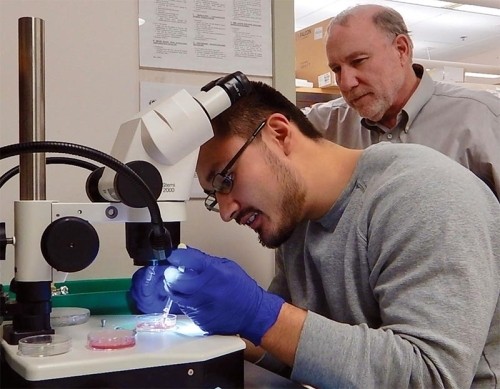
Most microorganisms that digest and recycle woody material do so by producing enzymes that accelerate chemical reactions to break down molecular compounds in the wood. Brown-rot fungi, the most common decay fungi in North America, use a different process, which was just discovered by a researcher at the University of Massachusetts Amherst. The process potentially could be exploited to convert biomass into other useful substances.
According to Barry Goodell, a professor of microbiology, there are thousands of species of decay fungi, about six percent of which are brown-rot species.
“Brown-rot fungi are everywhere. You probably breathe in their spores and fungal fragments continuously, even in your home,” he said. “If you look at your front porch and it has decay in it, it was probably caused by brown rot. It causes wood to become brown and crumbly when it’s dry, and in advanced stages, you can get cubes of wood that pop right out.”
Early in his career, Goodell discovered that brown-rot fungi produce none of the enzymes required to break down lignin. Instead, they use what Goodell calls a “chelator-mediated Fenton system,” a process that makes use of hydrogen peroxide generated by the fungi and iron, which is found in the environment. Chelators are organic compounds that bind metal ions and, in this case, generate hydroxyl radicals that degrade hydrocarbons to break down wood and produce simple building-block chemicals.
“Because of their efficiency in degrading wood, brown-rot fungi have come to dominate, particularly in degrading softwoods,” Goodell said. These fungi naturally recycle approximately 80 percent of the softwood biomass carbon in the world.
Since brown-rot fungi evolved from ancient white-rot fungi and came into existence much later than most other decay organisms, Goodell considers the process used by brown-rot fungi to be “an advanced system” and “the most efficient way of degrading wood.” He believes biorefineries should use the process to convert biomass into energy, bioplastics, and other products.
“In a bio-based economy, instead of getting products from oil, we get them from biomass,” he said. “But to make those products, we have to first break down the wood, and doing so using enzymes is probably the wrong way to think about it. Fungi have had 400 million years to think about the best way to break down wood, and they figured out this chelator-mediated system is the most efficient way.”
Goodell is conducting laboratory studies to identify products that could be created this way. He has converted lignin degraded by fungi into glues that he said are as effective as the resins used in plywood. And he has taken compounds produced from cellulose and made them into bioplastics.
“Fungi take months to degrade wood, but we’ve been able to take the chemicals they produce and, in a few hours, get 75 percent degradation,” he said. “Getting industry to adopt the process will take some time, though.”


Discussion *